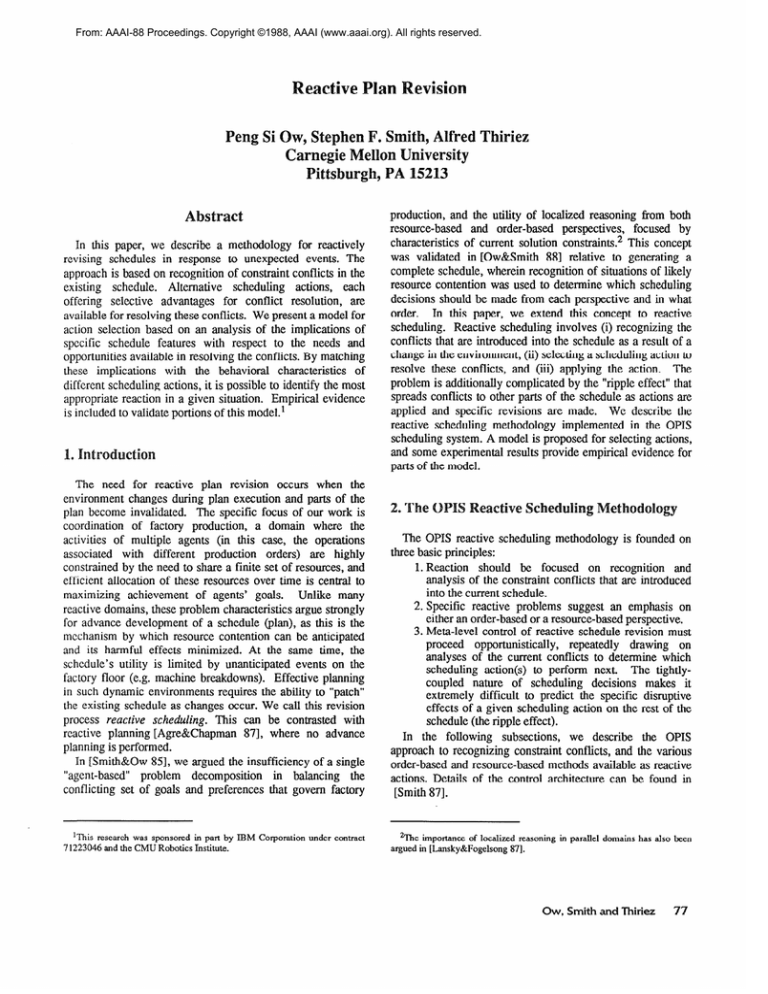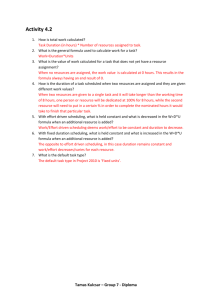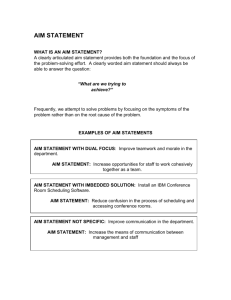
From: AAAI-88 Proceedings. Copyright ©1988, AAAI (www.aaai.org). All rights reserved.
eaetive Plan
Peng Si Ow, Stephen F. Smith, Alfred Thiriez
versity
213
Ah3 tract
In this paper, we describe a methodology for reactively
revising schedules in response to unexpected events. The
approach is based on recognition of constraint conflicts in the
existing schedule. Alternative scheduling actions, each
offering selective advantages for conflict resolution, are
available for resolving these conflicts. We present a model for
action selection based on an analysis of the implications of
specific schedule features with respect to the needs and
opportunities available in resolving the conflicts. By matching
these implications with the behavioral characteristics of
different scheduling actions, it is possible to identify the most
appropriate reaction in a given situation. Empirical evidence
is included to validate portions of this mode1.l
production, and the utility of localized reasoning from both
resource-based and order-based perspectives, focused by
characteristics of current solution constraints2 This concept
was validated in [Ow&Smith 881 relative to generating a
complete schedule, wherein recognition of situations of likely
resource contention was used to determine which scheduling
decisions should be made from each perspective and in what
order. In this paper, we extend this concept to reactive
scheduling. Reactive scheduling involves (i) recognizing the
conflicts that are introduced into the schedule as a result of a
change in the environment, (ii) selecting a scheduling action to
resolve these conflicts, and (iii) applying the action. The
problem is additionally complicated by the “ripple effect” that
spreads conflicts to other parts of the schedule as actions are
applied and specific revisions are made. We describe the
reactive scheduling methodology implemented in the OPIS
scheduling system. A model is proposed for selecting actions,
and some experimental results provide empirical evidence for
parts of the model.
The need for reactive plan revision occurs when the
environment changes during plan execution and parts of the
plan become invalidated. The specific focus of our work is
coordination of factory production, a domain where the
activities of multiple agents (in this case, the operations
associated with different production orders) are highly
constrained by the need to share a finite set of resources, and
efficient allocation of these resources over time is central to
maximizing achievement of agents’ goals.
Unlike many
reactive domains, these problem characteristics argue strongly
for advance development of a schedule (plan), as this is the
mechanism by which resource contention can be anticipated
and its harmful effects minimized. At the same time, the
schedule’s utility is limited by unanticipated events on the
factory floor (e.g. machine breakdowns). Effective planning
in such dynamic environments requires the ability to “patch”
the existing schedule as changes occur. We call this revision
process reactive scheduling. This can be contrasted with
reactive planning [AgreLkChapman 871, where no advance
planning is performed.
In [Smith&Ow 851, we argued the insufficiency of a single
“agent-based” problem decomposition
in balancing the
conflicting set of goals and preferences that govern factory
The OPIS reactive scheduling methodology is founded on
three basic principles:
1. Reaction should be focused on recognition and
analysis of the constraint conflicts that are introduced
into the current schedule.
2. Specific reactive problems suggest an emphasis on
either an order-based or a resource-based perspective.
3. Nleta-level control of reactive schedule revision must
proceed opportunistically,
repeatedly drawing on
analyses of the current conflicts to determine which
scheduling action(s) to perform next. The tightlycoupled nature of scheduling decisions makes it
extremely difficult to predict the specific disruptive
effects of a given scheduling action on the rest of the
schedule (the ripple effect).
In the following subsections, we describe the OPIS
approach to recognizing constraint conflicts, and the various
order-based and resource-based methods available as reactive
actions. Details of the control architecture can be found in
[Smith 871.
‘This research was sponsored in part by IBM Corporation
7 1223046 and the CMU Robotics Institute.
?he importance of localized reasoning
argued in [Lansky&Fogelsong
871.
under contract
in parallel
domains
has also been
Ow, Smith and Thiriez
77
2.1. Recognition
of Constraint
Conflicts
Detection of constraint conflicts in the current schedule is
the means by which the need for reaction is recognized within
OPIS. Conflict detection is accomplished by incrementally
maintaining descriptions of the current time bounds on
operations and the current availability of required resources,
both of which are represented at multiple levels of abstraction.
Whenever changes are made to the descriptions of specific
operations or resources, these new constraints are combined
with model-defined constraints on production processes and
resources to update the descriptions of related operations and
resources. Constraint propagation in response to schedule
changes can lead to detection of two types of conflicts:
0 time conflicts - situations where the time bounds (i.e.
scheduled or actual execution times) of two operations
belonging to the same production plan are inconsistent,
and
0 capacity conflicts - situations where the resource
requirements of a set of currently scheduled operations
exceeds the available capacity of a resource over some
interval of time.
This schedule maintenance subsystem is described in more
detail in [LePape&Smith 871.
To determine the actual focal point around which reaction
should be centered on any given problem solving cycle, some
aggregation of the currently posted conflicts may be
necessary. Conflict aggregation is intended to group together
those individual
constraint
conflicts that should be
simultaneously addressed, and, for purposes of this paper, is
based on commonality of the resources involved in the conflict
at some level of aggregation. In the case of capacity
violations, this is (obviously) the resource being contended
for. In the case of time conflicts, we assume that the
downstream resource (as determined by the precedence
constraint leading to the conflict) is the resource of interest
from the standpoint of aggregation.
We designate this
resource as the focal point resource. It is important to note
that this resource is itself typically an aggregate (i.e. a group
of machines) with some amount of capacity.
2.2. Actions for Resolving
Constraint
Conflicts
Before turning attention to issues relating to conflict
analysis and selection of reactive scheduling actions, we
briefly describe the scheduling actions available in OPIS.
Table 2-1 summarizes the behavioral characteristics of each
alternative. The entries for a given action are assigned values
in the range from 0 to 1 (with 0 being the lowest possible
rating and 1 the highest), and these values are intended to
broadly indicate the relative strengths and weaknesses of each
action. In more detail, these scheduling actions include:
e Order Scheduler (OK) - OSC provides a method for
generating or revising scheduling decisions relative to
some contiguous portion of a given order’s production
plan. It implements the constraint-directed heuristic
78
Automated
Reasoning
search technique originally developed in the ISIS
scheduling system Fox&Smith 841. This method is
characterized by the use of a beam search to explore
alternative sets of resource assignments and execution
intervals, evaluating various alternatives with respect to
how well the decisions satisfy relevant preferences (e.g.
work-in-process time objectives, machine preferences).
In invoking OSC, resource availability constraints can
be made more or less visible. It can either be
constrained to consider only execution intervals for
which resource capacity currently exists, which we
designate as the complete visibility (CV) OSC, or
allowed to consider capacity allocated to lower priority
orders as available, which we designate as the
prioritized visibility (PV) OSC. Since the latter case
admits the possibility of introducing additional capacity
conflicts into the schedule (leading to “bumping” of
lower priority orders), a decision to invoke the PV-OSC
trades off potential additional disruption for some ability
to perform resource-based optimization (hence the value
0.5 for this characteristic in Table 2-l).
* Resource Scheduler (RX) - RSC provides a method for
generating or revising the schedule of a designated
resource (typically aggregate).
The method is
predicated on the assumption that contention for the
resources in question is high and, thus, emphasizes
efficient resource utilization. It generates scheduling
decisions using an iterative dispatch-based approach,
selectively employing a collection of dispatch heuristics
to provide sensitivity to different preferences. Details of
this approach may be found in [Ow&Smith 881. In
reactive contexts, RSC selectively applies the same
strategy. It tentatively assumes that a complete new
schedule will be generated forward in time from the
point of the current conflict, but stops as soon as the
new schedule can be consistently merged with the
fragment of the old schedule that contains just those
operations that have yet to be placed in the new
schedule. Since the RSC places sole emphasis on
resource-based optimization, the likelihood of additional
disruption of the schedule due to time conflicts with
downstream operations is high.
0 Right Shifter (RSH) - The RSH implements
a
considerably less sophisticated reactive method which
simply “pushes” the scheduled execution times of
designated operations forward in time by some
designated amount. Such initial shifts can introduce
both time conflicts and capacity conflicts. However,
these conflicts are internally resolved by propagating the
shifts through resource and order schedules to the extent
necessary. Thus, the RSH will not introduce any new
conflicts into the overall schedule.
0 Demand Swapper (DSW) - Demand swapping is a
specialized reactive method that exchanges the
remaining portion of one order’s schedule with the
correspondent portion of the schedule of another order
of the same type so as to minimize their combined
tardiness.
Note that the DSW is not necessarily a
conflict resolution strategy. It is more appropriately
viewed as a scheduling action that improves the
character of the conflict.
previously made at the focal point resource remain
valid. The problem lies only in the timing details. If the
duration is high, however, this assumption is not valid.
0 number of operations in conflict - If the number of
conflicting operations is low, then it is reasonable to
assume that most sequencing decisions relative to the
focal point resource are valid. For example, if there is
only a single conflict, then the operation in conflict may
be the only one out of sequence. If the number is high,
then sequence optimization at the focal point resource is
an important concern.
The implications of these features are summarized in Table
3-1.
Table 2-1:
easoning
Characteristics of Scheduling Actions
About
Given the scheduling actions described above, the control
problem is: How to best exploit the selective advantages of
each in reactively resolving conflicts? As a first step to
addressing this question it is important to consider criteria for
evaluating the utility of various reactive revisions to the
current schedule. We identify three:
8 attendance to scheduling objectives - This concerns the
“quality” of the result relative to expected factory
behavior.
e amount of disruption - This concerns the extent to which
reaction has been localized.
69efficiency of reaction - This concerns the speed of the
reactive revision process.
In the following subsections, we focus on the control
problem stated above. We first identify a set of features
relevant to conflict analysis. Then, on the basis of the
implications of these features in relation to the behavioral
characteristics of the specific scheduling actions identified in
Section 2.2, we arrive at a model for selecting appropriate
reactions.
3.1. Conflict Analysis
Me&level control decisions should exploit knowledge
relating to both the continuing validity of various scheduling
decisions and the flexibility of current time and capacity
constraints. Our goal in this section is to identify a set of
features that provides this knowledge. We begin by
considering specific characteristics of the conflict itself:
e conflict duration - The duration of the conflict (or the
maximum of the durations of the individual constraint
conflicts if several have been aggregated) provides one
indicator of the validity of the focal point resource’s
schedule. Appealing to sensitivity analysis [Bean&Birge
85, Johnson 741, if the duration is low, then it is
reasonable to assume that the sequencing decisions
-
Duration
Number of
Operations
Implication
low
-------------
sequencing decisions
remain valid
high
low
small sequence changes
needed
high
high
sequence optimization
needed
Table 3-I:
Implications of Conflict Characteristics
We next consider features relating to the flexibility of
current time and capacity constraints in the schedule. Here we
are only interested in the local flexibility surrounding the
conflict.
To this end, we define the conj’lict horizon, an
interval that temporally spans the conflict by some reasonable
margin, to place temporal bounds on the analysis. We identify
several additional features:
@fragmentation of focal point resource’s schedule - This
is a profile of amount of available capacity at the focal
point resource over the conflict horizon (recall we are
typically speaking of an aggregate resource). If
fragmentation is low, then the focal point resource is a
bottleneck, indicating that optimization of the focal
point resource’s schedule to achieve maximum
throughput is a primary concern. If fragmentation is
high, then resource-based optimization is unimportant.
0 local downstream slack - This measure captures the
local flexibility in the scheduled end times of the
operations scheduled on the focal point resource. In
defining this measure, we appeal to an assumption
concerning characteristics of a good schedule, namely
that good schedules will exhibit queue times only before
bottleneck resources. Given this assumption, we define
local downstream slack to be the average of the
durations of the first scheduled delay due to resource
unavailability encountered by each order scheduled on
the focal point resource within the conflict horizon. If
there are no scheduled delays in an order’s schedule,
then there is no local slack. If downstream slack is low,
then downstream resource contention is not likely to be
severe (i.e.
there are no apparent downstream
bottlenecks).
If downstream slack is high, there is
evidence of at least one downstream bottleneck and
optimization of resource schedules further downstream
Qw, Smith and Thirlez
79
3.2. Selecting
may be important.
ScheduIing
Actions
0 local upstream slack - This measures the flexibility in
the scheduled start times of the operations scheduled on
the focal point resource. In this case, slack can be
defined in terms of the scheduled (or actual) end times
of the immediately preceding operations (given the
above assumption about the starting schedule). If the
local upstream slack of operations requiring the focal
point resource is high, then there are opportunities for
resequencing on the focal point resource. It might be
possible to place operations into the “holes” of available
capacity that will be vacated by the conflicting
operations.
0 projected lateness - Relative to the specific operation(s)
in conflict we also define a related measure of projected
lateness. The projected lateness of an operation is
defined in a similar manner to local downstream slack,
except now we are interested in the difference between
the earliest time that the order can arrive at the
downstream bottleneck and its scheduled start time on
that resource. If there is no downstream bottleneck,
then we are interested in the difference between the
earliest the order can finish and its due date. If the
projected lateness of an operation is negative (i.e. the
operation is still “early” relative to its current deadline),
then resource-based optimization is unimportant. If the
lateness is positive, then resource-based optimization is
important.
In the previous section, we identified specific features of
the current state of the schedule and indicated their
implications relative to the validity of sequencing decisions,
the opportunities for either order-based or resource-based
These
optimization, and the scope of the reaction.
implications distinguish some scheduling actions as being
more appropriate than others with respect to the evaluation
criteria stated earlier. Thus, by consolidating these features of
the current control state and analyzing their various
implications,
it is possible to deduce the desirable
circumstances for each scheduling action and hence select the
most appropriate scheduling action to apply in a given
situation. The results are summarized in Figure 3-l below.
0 variance in projected lateness of all operations in the
conflict horizon - This provides an indication of the
opportunities
for pair-wise optimization
of order
schedules. If the variance is high, then it may be
possible to tradeoff positive and negative projected
latenesses of specific orders by swapping demands.
The implications of these features relating to constraint
flexibility are summarized in Table 3-2.
0%osc
DSW
PV-osc
PV-osc
0
0
Measure
Value
Implication
Fragment.
at focal point
resource
low
high
resource-based optimization
important
resource-based optimization
unimportant
Downstream
slack
low
high
no downstream bottlenecks
existence of downstream
bottleneck(s)
Upstream
slack
low
limited flexibility for
resequencing
opportunities for resequencing
high
80
Projected
lateness of
conflicting
operations
neg.
Variance in
projected
lateness
low
resource-based optimization
unimportant
resource-based optimization
important
pos.
high
no opportunities
for demand swapping
opportunities
for demand swapping
(in conjunction with + lateness)
Table 3-2:
Implications of Constraint Flexibility
Automated
Reasoning
Figure 3-1:
RSC
schsdllfsFestum
RSC
--RSC
PV-osc
RSH
Implication of feature
Decision tree for selecting actions
As shown in Figure 3-1, when the conflict duration is short
(implying that the sequencing decisions of the current
schedule are still valid), RSH is postulated as the most
appropriate action to take. This is because RSH resolves
conflicts while maintaining the stability of the sequence in an
efficient manner. There is a need for some reoptimization
when the conflict duration is long. When the conflict centers
on a resource with low or no fragmentation (i.e. a bottleneck
resource), a resource perspective is needed to ensure that
critical resource-based constraints and goals are optimized by
Conversely, a highly fragmented resource
the reaction.
schedule
provides
an
opportunity
for
order-based
optimization. To select a particular scheduling action within
each perspective requires further analysis of the current
control state.
If a resource-based reaction is appropriate, there are two
possible actions: RSC and PV-OSC (with the scope of the
action limited to just the conflicting operations). If either the
number of conflicting operations is high or there is upstream
slack that can be exploited for resequencing purposes, then
RSC is the most efficient and effective reactive action that can
be taken. This follows from its strength in optimizing the
utilization of a particular resource. However, if only one or
two conflicting operations are present and there is little
upstream slack, then PV-OSC may be sufficient. In this case
the resequencing problem is constrained to one of simply
repositioning the conflicting operation(s) within the focal
point resource’s schedule.
Under the order-based perspective, we may choose between
three actions: CV-OSC, PV-OSC and DSW. If there is plenty
of slack in meeting the due date of an order involved in a
conflict, the CV-OSC is preferable as it minimizes disruption
to the existing schedule without threat of the order being tardy.
However, if the conflict compromises the quality of the
schedule relative to order tardiness, a more aggressive
approach to order scheduling is needed. When there is a high
variance in the projected lateness of jobs, an opportunity may
exist to swap demands with DSW. Note however, that DSW
acts more to improve the nature of the current conflict, and as
a rule is not used more than once per externally generated
conflict.
PV-OSC provides a consistent, more aggressive
approach to order scheduling.
One additional consideration in selecting actions which is
not reflected in Figure 3-l is the scope of the reaction. In the
case of resource-based reactions, the scope is naturally the
focal point resource. However, in the case of order-based
reactions, the scope should depend on extent of resource
contention further downstream. Specifically, if downstream
slack is high (indicating the presence of downstream
bottleneck resources), then the scope of an order-based
scheduling action is limited to the portion of the order’s
production plan that precedes the downstream bottleneck
operation. This provides the opportunity to take full advantage
of the strengths of resource-based scheduling actions.
3.3. Experiments
To test the proposed model for selecting scheduling actions,
a series of experiments involving a specific set of reactive
problems has been designed. Each reactive problem is defined
by generating a “starting” schedule, establishing a current
“state of execution” at some point within the schedule and
then introducing either a machine breakdown or an operation
processing failure (implying extra repair operations).
The
problems have been specified so as to ensure that all
combinations of the schedule features are enumerated. Each
experiment then consists of applying alternative scheduling
To empirically verify that the
actions to each problem.
proposed model is correct, it is necessary to show that its
prescribed action performs as well or better than actions not
An added complication occurs
prescribed by the model.
because certain actions chosen may not leave the schedule
conflict-free. It is not possible to evaluate the quality of a
schedule with conflicts, so that for these situations, the
performance evaluation applies to a series of reactive
scheduling actions. For these cases, it is only possible to test
that the successive actions as prescribed by the model give
equal or better performance than deviations from the model.
Table 3-3 summarizes the experimental results that have
been obtained to date. It shows, for each reaction cycle, both
the action(s) that performed best according to the criteria
stated earlier and the action prescribed by the model. As can
be seen, the actions prescribed by the model in each
experiment were among the best.
In this paper, we have advocated an opportunistic
methodology for reactive scheduling based on focused
Actions
Schedule Features*
,xp. Cycle
#
Conflict
Duration
Fragmentation
Upstream
Slack
Downstream
Slack
Lateness
Best
Actions
RSH,
1,3
1
short
high
no
n0
negative
2
1
long
moderate
no
no
negative
1,
short
high
Yes
no
negative
4
i-8
1{2
;
:
long
long
9
:7
RSH
cv-osc
RSH
RS$l$H
long
short
long
long
2
cEITc
cw.&
Prescribed
Action
kwh
high
Yes
Yes
Yes
no
$3
Yes
positive
posiuve
negative
negative
low
high
Yes
no
no
no
positive
positive
low
Yes
RSH
RSC
PV-OSC,
%F
PV-OSC,
cv-osc
RSC
RR;:
cv-osc
RSC
PV-osc
Verified that DSW is able to take advanta e of wide lateness variance.
Verified that RSC is better than PV-OSC wi en upstream slack is present.
* All schedules have wide lateness variance.
Table 3-1: Experimental Results
Ow, Smith and Thiriez
81
analysis of the conflicts introduced into an existing schedule.
The methodology presumes the availability of a set of
alternative scheduling actions, each of which operates with
respect to a particular local perspective of the problem and
offers selective advantages for conflict resolution. We have
focused specifically on the me&level
control problem,
considering the issue of conflict analysis and presenting a
model for selecting among potential actions. Before closing,
we briefly discuss those aspects of the overall reactive
problem that have not been addressed.
Our model of conflict analysis and reaction selection
emphasizes schedule quality.
Efficiency concerns are
addressed only to the extent that disruption to the starting
schedule is minimized by revising only those scheduling
decisions that are found to be invalid, and minimizing
disruption is correlated to reactive efficiency. However, the
pragmatics of reacting within a specified time frame have
clearly not been addressed. In this regard, two points can be
made:
0 One characteristic of the model is that revision of the
schedule proceeds forward in time. Once the first
scheduling action has been completed, the immediate
conflict has been solved and revision is now centered on
responding to the downstream consequences of this
action. Thus, the immediately needed scheduling
decisions are now valid. If necessary, the system could
suspend work on the residual problems and focus on
other more pressing matters. This requires a framework
for prioritizing and managing pending conflicts. Here,
recent work in reactive planning architectures [Georgeff
87, Firby 871 is directly relevant
0 The efficiency of individual scheduling actions can be
influenced by a number of factors, including level of
abstraction of the problem/schedule, search parameters,
and the use of problem-specific heuristics.
ll?rby 871
Firby R.J.
An Investigation into Reactive Planning in
Complex Domains.
In Proc. AAAZ-87, pages 202-206. Seattle,
WA, July, 1987.
[Fox&Smith 841 Fox, M.S., and SF. Smith.
ISIS: A Knowledge-Based System for
Factory Scheduling.
Expert Systems 1(1):25-49, July, 1984.
[Georgeff 871
Georgeff M.P.
An Embedded Real-Time Reasoning
System.
In Proc. 2nd Annual NASA Artificial
Intelligence Research Forum, pages
286-329. Palo Alto, CA, 1987.
[Johnson 741
Johnson, L.A. and D.C. Montgomery.
Operations Research in Production
Planning, Scheduling and Inventroy
Control.
John Wiley, 1974.
lLansky&Fogelsong
871
Lansky, A.L. and D.S. Fogelsong.
Localized Representation and Planning
Methods for Parallel Domains.
In Proc. M-87,
pages 240-245. Seattle,
WA, July, 1987.
[LePape&Smith 871
LePape, C. and S.F. Smith.
Management of Temporal Constraints for
Factory Scheduling.
In C. Rolland, M. Leonard, and F. Bodart
(editors), Proc. IFIP TC 8/W% 8.1
Working Conf. on Temporal Aspects in
Information Systems (TAIS 87), pages
165-176. Elsevier Science Publishers,
May, 1987.
Acknowledgements
We gratefully acknowledge the long hours spent by Dirk
Matthys and Jean-Yves Potvin in running the experiments and
their help in analyzing the results. Thanks also to Chris
Young for his work in developing the OPIS testing
environment.
[Agre&Chapman 871
Agre, P.E. and D. Chapman.
Pengi: An Implementation of a Theory of
Activity.
pages 268-272. Seattle,
In Proc. M-87,
WA, July, 1987.
[Bean&Birge 851 Bean, J.C., and J.R. Birge.
Match-Up Real-Time Scheduling.
Technical Report 85-22, Univ. of Michigan
Dept. of Industrial and Operations
Engineering, June, 1985.
Automated
Operations Research: Approaches to
Intelligent Decision Support, pages
85- 108. Baltzer Scientific Publishing
Co., 1988.
[Smith 873
References
82
[Ow&Smith 883 Ow, P.S. and S.F. Smith.
Viewing Scheduling as an Opportunistic
Problem Solving Process.
In R.G. Jeroslow (editor), Annals of
Rwoning
Smith, S.F.
A Constraint-Based Framework for
Reactive Management of Factory
Schedules.
In M. Oliff (editor), Proc. 1st Inter. Conf
on Expert Systems and the Leading
Edge in Production Management, pages
349-366. Charleston, SC, May, 1987.
[Smith&Ow 851 Smith, S.F. and P.S. Ow.
The Use of Multiple Problem
Decompositions in Time-Constrained
Planning Tasks.
In Proc. IJCAI-8.5, pages 1013-1015. Los
Angeles, CA, August, 1985.




